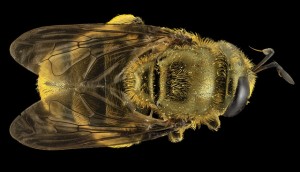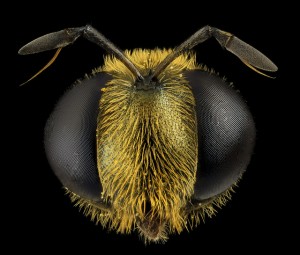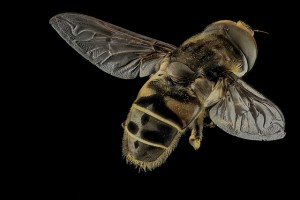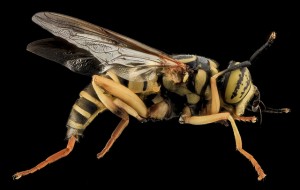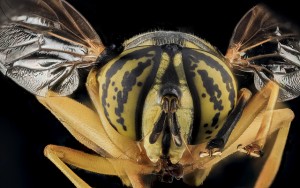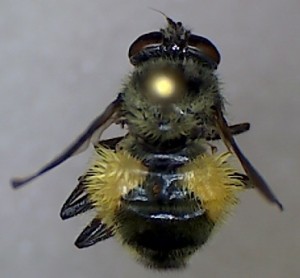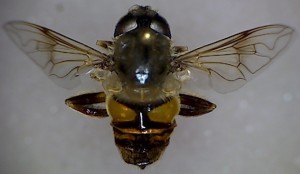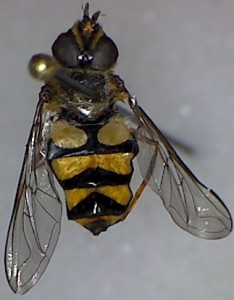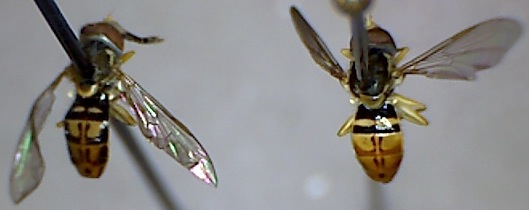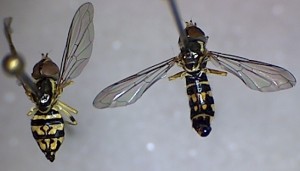NOT BEES
Hoverflies (Order Diptera: Family Syrphidae)
Syrphid flies are sometimes called flower flies or hoverflies. Many species mimic bees and are often confused with them. The easiest way to tell bees and flies apart is that bees have 2 pairs of wings and flies have only 1 pair of wings.
Hoverflies, with over 6,000 species, are the most numerous of the pollinating flies. These flies are often seen hovering or feeding on nectar in flowers. In some species, the larvae are insectivores and prey on plant parasites such as aphids, thrips, and other plant-destroying insects.
Pollinating flies visit over 1,100 different species of flowers, many of which are important crops in human agriculture. Each time a fly visits a flower there is a chance for pollination. Many pollinating flies have even evolved hairy bodies to provide a better surface for pollen distribution from one flower to another. Flowers encourage visits from pollinating flies with sweat tasting nectar.
In Georgia agriculture, hoverflies play key pollination roles especially on overcast and low temperature days. Bees generally stay in their nests on these poor weather days; however, flies are active and visit many flowers even in the poor weather. Thus, early in the season and on rainy day, flies are the only pollinators in orchards and farms.
Photos taken by Sam Droege and staff at the USGS Bee Inventory and Monitoring Laboratory (Used with permission)
In a 2014, we conducted a survey of hoverflies in Georgia Apple Orchards. There were 31 species of hoverflies collected. The most abundant hoverfly species were: Toxomerus geminatus, Toxomerus marginatus, and Allograpta exotica. (See study below)
During the course of the study, hoverflies were observed numerous times pollinating different flowers. Hoverflies were also observed in orchards 2 to 4 weeks prior to the emergence of native bees and other pollinators.
During the past 5 years in the southeast, significantly different seasonal weather patterns, especially for early blooming crops (apples, blueberries), has illustrated the value of having a wide range of native pollinators. For example in 2012, hoverflies were present in North Georgia apple orchards more than 3 weeks before the emergence of native bees. They were the only native pollinator present in good numbers to pollinate the apple flowers during bloom that year. The flies took over as the main native pollinator during that season.
Photos by Catherine Schlueter
Presentations at Recent Conferences
An Examination of Hoverfly (Family Syrphidae) Diversity and Collection Methods in Georgia Apple Orchards. 2015 Southeastern Branch Meeting of the Entomological Society of America. Biloxi, MS. March 15-18, 2015. Oral Presentation by Catherine G. Schlueter and Mark A. Schlueter.
Hoverflies (Family Syrphidae) are a useful group of pollinating insects that have often been overlooked due to the importance of bees as pollinators. Hoverflies mimic bees in external anatomy (black and yellow color patterns). A survey of Family Syrphidae was performed from March to August 2014 at four large apple orchards in North Georgia (8 collections per site). Collection methods included: pan traps, malaise traps, and one-hour timed sweep netting. There were 277 hoverflies collected during the season. These hoverflies consisted of 31 species in 17 different genera. The most abundant hoverfly species were: Toxomerus geminatus (n=114), Toxomerus marginatus (n-47), and Allograpta exotica (n=27). The species collected indicate a diverse assembly of hoverflies in Georgia. Hoverflies significantly (p= .0001) preferred yellow trap color to other colors (blue and white). Hoverflies did not show bias for other factors such as pan trap position (ground or elevated). Pan traps collected the largest raw number of hoverflies and the most different species. During the course of the study, hoverflies were observed numerous times pollinating different flowers. Hoverflies were also observed in orchards 2 to 4 weeks prior to the emergence of native bees and other pollinators. The state of Georgia has a diverse group of hoverflies from many different genera. This survey is the first step in discovering and documenting the diversity and abundance of hoverflies in the southeastern United States. Based on other regional studies (e.g. Oklahoma – Shorter and Drew 1976) in the past, it is likely Georgia has 40-80 species. Additional surveys are needed to fill in the complete picture of the biodiversity of these important pollinators and pest-mangers.
